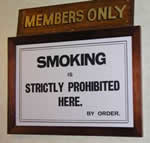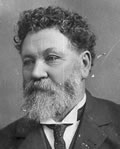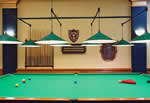MPs: Social life
Parliament used to be a bit like a superior gentlemen's club. MPs often inhabited Parliament Buildings around the clock, drawn there by Bellamy's restaurant, which served the best fare in the country, and its bar, which served the finest liquor at cheap rates. The buildings were full of nooks and crannies in which to sit and pass the time of day, or more formal areas, like the Lobby where MPs could horse-trade and gossip. There were organised entertainments and impromptu concerts, sweepstakes on the races, and billiard and debating competitions.
Hear Francis Fisher, MP between 1905 and 1914, discuss social life in Parliament (207k, mp3). See transcript and more information about this file.
Bellamy's
Call it symbolic, but the first bill passed by Parliament in 1854 was the 'Bellamy's bill', the Licensing Amendment Act, that permitted the sale of alcohol within the premises; they even suspended standing orders to do it! 'Setting up a grog-shop for members', Legislative Councillor Frederick Whitaker, called it. New Zealand followed Britain and called its parliamentary refreshment room Bellamy's, named after John Bellamy who set up shop in the House of Commons in 1773.
The move to Wellington saw Bellamy's on its way to becoming the country's premier restaurant although women were not able to dine there for many years. Expensive silver plate and cutlery, crockery and table linen were shipped in from Britain. The china was white with a blue border and it and the glassware bore the General Assembly crest.
The finest liquor in the land
Bellamy's stocked the best liquor in the country and MPs did it proud. In 60 sitting days the short session of 1871 got through 50 dozen bottles of champagne, a hogshead and 72 bottles of claret, 4 casks of sherry, a cask of port, 4 casks of wine and £100 of spirits, to say nothing of the selection of ales, wines, and liqueurs. Bellamy's kept a cellar, tested the proof of imported spirits, and broke down and bottled spirits for sale both over the bar and by the bottle or case to MPs. Its own brand of liquor was exclusively for the parliamentarians.
Not everyone was happy. Hugh Carleton, the first MP elected in 1853, wanted Bellamy's abolished in order to 'raise the character of the House ... [and] to preserve its influence in the country', but the House wasn't convinced.
The temperance movement also thought Bellamy's set a bad example. In the early 1890s, as the movement gained strength, Parliament conceded that Bellamy's bar should close earlier. In 1896 Premier Richard Seddon orchestrated a compromise: at the beginning of each Parliament MPs would vote to see whether liquor should be provided. As he knew, most would always say yes; the polls continued until the 1960s.
In the drink
John McLachlan, elected for Ashburton in 1893, was a Scotsman with a fondness for Burns and whisky, and 'about the wildest looking specimen in the Parliamentary collection'. He spoke in the House while intoxicated, often using bad language. Shortly after the opening of the 1894 session, he fell into the harbour while wandering home, after mistaking wharf lights for those in a nearby chemist's shop. He was fished out, clinging to a piece of timber.
He told the story to his colleague Alexander Hogg in his broad Scots accent: 'That's the chemist's shop' thocht I an on I trudged keeping the bonny colors in my eye, when just as I was coming up to them my feet tripped an ower I went heid foremost souse intil the water ... Altho it was verra dark when my head bobbed aboon the waves I saw a black pile in front o' me an I said tae masel, "here's the rock o' ages". I don't think ever I clespit Mrs Mac sae ticht as I clespit that lump o' timber. I farily hugged it tho' it was michty uncomfortable for the waves kept liftin me up an doon like a seagull intil I got straddle legs across a crossstay where I rode at anchor for twa guid hours. ... "Weel! Weel! Mac" says I tae masel, "Ye were never in sic a plicht as this before; I wonner if ye'll see it oot, or is this a jidgment sent on ye for bacomin a member an leevin Mrs Mac and the bairns at hame?"' After this his wife came to Wellington for the sessions to keep an eye on him.
Journalist Tom Scott remembered Bellamy's in what was left of the old Government House just before its demise in the mid 1970s. It was
'a ramshackle old wooden structure that leant against the south wall of the main building. It was always busy. You came down ricketty stairs through an air-lock of cooking smells, tobacco smoke and hops. Early evening it had the casual gaiety of a benign riot. The bar was one of those continuous counter affairs you still find at the odd country racecourse. Thin partitions segregated the various castes. At the far end messengers got a bare wooden floor. Next door the press got stained lino. The Members and Guests and Members Only bars graduated to greasy carpet flecked with cigarette burns. People entered the cubicle befitting their status, hung up coats, tucked briefcases against the walls, and checked the stainless steel warming drawers to see what tasty morsels were left over from lunch. Sometimes there were crumbed oysters and sweetbreads but mostly it was fish in limp jackets of batter, but once fortified they were ready to battle through the crush to the bar.'
Salad Days

Bellamy's bar today.
In the mid 1970s Bellamy's moved into the Beehive. It now used the same tableware in all dining rooms, Crown Lynn crockery incorporating a stylised Maori motif. 'Lounges' with comfortable low seating replaced the old-style 'bars' with high counters. The layout of the Beehive made it difficult and expensive to distribute food and liquor. Bellamy's was reorganised in the 1990s. The ministerial dining room was closed and the MPs' and guests' dining room opened up to all parliamentary staff and guests. Over time, the menu became less lavish, with more healthy food offered, such as salads. The days of élite splendour were over.
Learn more about Bellamy's on the Parliamentary Service website.
Parliamentary balls
Balls were regularly held at Parliament, and they spiced up life in Auckland and Wellington in the early days. In the 1870s Premier Julius Vogel's official residence became known as 'The Casino'. A ball in 1871, held in honour of the Governor, saw the interior of the buildings completely changed, including the addition of 'no fewer than "18 quiet little flirtation nooks"'. Five hundred attended, and the banquet was topped off by peacocks in full plumage and a boar's head as the centrepiece. Wellington's Evening Post newspaper crowed that 'no London or Paris ballroom could have outshone the beauty or the elegance' and they said that the floor of the old Legislative Council made an excellent dance floor when 'well polished and liberally top-dressed with spermaceti'.
Hear Francis Fisher, MP between 1905 and 1914, discuss parliamentary humour (622k, mp3). See transcript and more information about this file.
Billiards
MPs had to wait until Parliament House was built to be able to play billiards and snooker. The members' lounge became the centre of social activities, for men at least. National and Labour had their own tables, and there was one mixed party table. MPs took the game very seriously, and championships were keenly contested with shields to be won.
Next: MPs: Travel >



